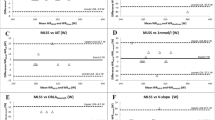Abstract
The correlation between the behaviour of the heart rate/work performance (f c W) curve and blood lactate ([la]b) and plasma adrenaline/noradrenaline concentrations ([A]/[NA]) during incremental cycle ergometer exercise was investigated. A group of 21 male sports students was divided into two groups: group I, with a clear deflection of thef c W curve; group II, without or with an inverse deflection of thef c W curve. The aerobic threshold (Thaer) and the lactate turn point (LTP) were defined. Between Thaer and maximal work performance (f c W max) the behaviour of thef c W curve as well as the behaviour of [la−]b and [A]. [NA] were described mathematically. Thef c, systolic blood pressure (BPS),W, [la−]b, [A] and [NA] at rest, Thaer, LTP,f c W max, after 3 and 6 min of recovery (Re3/Re6) were calculated. A significant difference between the two groups could only be detected forf c at LTP, Re3 and Re6 (P < 0.05). No significant, correlation could be found between individualf c W-behaviour and individual time course of [la−]b, [A] and [NA]. However, a significant correlation was visible between [la−/W-behaviour and individual catecholamine response. These results and the fact that the different flattening at the top of thef c W curve was related to diminished stress-dependent myocardial function led us to the conclusion that it is possible that sympathetic drive is not directly involved in mechanisms of regulation between load dependentf c and myocardial function. In addition, individualf c W behaviour was independent of BPS andW max, or individual conditions of energy supply.
Similar content being viewed by others
References
Aunola S (1991) Aerobic and anaerobic thresholds as tools for estimating submaximal endurance capacity. Publications of Social Insurance Institution, ML 109. Thesis, University of Turku, Finland
Baumgartner H, Ritsch R, Luz, O, Schneeberger J., Hammerer I, (1992) Capillary versus arterial plasma catecholamines as markers for sympatho-adrenal activity in infants. Pediatr Res 31:579–582
Boehringer Mannheim (1987) Test-combination lactate fully enzymatic. Boehring Mannheim Diagnostica
Boucher CA, Kanarek DJ, Okada RD, Hutter AM, Strauss HW, Pohost GM (1983) Exercise testing in aortic regurgitation: comparison of radionuclide left ventricular ejection fraction with exercise performance at the anaerobic threshold and peak exercise. Am J Cardiol 52:801–808
Brooke JD, Hamley EJ (1972) The heart-rate-physical work curve analysis for the prediction of exhausting work ability. Med Sci. Sports Exerc 4:23–26
Bunc V, Heller J (1992) Comparison of two methods of noninvasive anaerobic threshold determination in middle-aged men. Sports Med Training Rehabil 3:87–94
Christensen NJ, Galbo H, Hansen JF, Hesse B, Richter EA, Trap-Jensen J (1979) Catecholamines and exercise. Diabetes 28: 58–62
Conconi F, Ferrari M, Ziglo PG, Droghetti P, Codeca L (1982) Determination of the anaerobic threshold by a noninvasive field test in runners. J Appl Physiol 52:869–873
Da Prada M, Zürcher G (1979) Simultaneous radioenzymatic determination of plasma and tissue adrenaline, noradrenaline and dopamine within the fentomole range. Life Sci 19: 1161–1174
Davis HA, Bassett J, Hughes P, Gass GC (1983) Anaerobic threshold and lactate turn point. Eur J Appl Physiol 50: 383–392
Euler US, Hellner S (1952) Excretion of noradrenaline and adrenaline in muscular work. Acta Physiol Scand 26:183–191
Gaisl G, Hofmann P (1991) Heart rate threshold standardisation of the modified conconi test for sedentary persons. In: Bachl N, Graham TE, Löllgen H (eds) Advances in ergometry. Springer, Berlin Heidelberg New York, pp 233–238
Hartley LH, Manson JW, Hogan RP, Jones LG, Kotchen TA, Mougey EH, Wherry FE, Pennington LL, Ricketts PT (1972) Multiple hormonal response to prolonged exercise in relation to physical training. J Appl Physiol 33: 607–610
Heck H, Beckers K, Lammerschmidt W, Pruin E, Hess G, Hollmann W (1989) Identification, objective and validity of Conconi threshold by cycle stress tests. Dtsch Z Sportmed 40: 388–412
Hofmann P, Pokan R, Preidler K, Leitner H, Szolar D; Eber B, Schwaberger G (1994) Relationship between heart rate threshold, lactate turn point and myocardial function. Int J Sports Med 15:232–237
Lehmann M, Keul J (1985) Capillary-venous differences of free plasma catecholamines at rest and during graded exercise. Eur J Appl Physiol 54: 502–505
Lehmann M, Keul J (1986) Free plasma catecholamines, heart rates, lactate levels, and oxygen uptake in competition weight lifters, cyclists, and untrained control subjects. Int J Sports Med 7:18–21
Mader A, Liesen H, Heck H, Philipi H, Rost R, Schurch P, Hollmann W (1976) Zur Beurteilung der sportartspezifischen Ausdauerleistungsfähigkeit im Labor. Sportarzt Sportmed 27:80–88, 5:109–112
Mazzeo RS, Marshall P (1989) Influence of plasma catecholamines on the lactate threshold during graded exercise. J Appl Physiol 67: 1319–1322
Pansold B, Zinner J (1991) Selection, analysis and validity of sportspecific and ergometric incremental test programmes. In: Bachl N, Graham TE, Löllgen H (eds) Advances in ergometry. Springer, Berlin Heidelberg New York, pp 181–213
Pierce D, Kupprat I, Harry D (1976) Urinary epinephrine and norepinephrine levels in women athletes during training and competition. Eur J Appl Physiol 36:1–6
Pokan R, Hofmann P, Preidler K, Leitner H, Dusleag J, Eber B, Schwaberger, G, Füger GF, Klein W (1993) Correlation between inflection of heart rate/work performance curve and myocardial function in exhausting cycle ergometer exercise. Eur J Appl Physic 67: 385–388
Ribeiro JP, Fielding RA, Hughes V, Black A, Bochese MA, Knuttgen HG (1985) Heart rate break point may coincide with the anaerobic and not the aerobic threshold. Int J sports Med 6:220–224
Yamaguchi N, Champlain J de, Nadeau R (1975) Correlation between the response of heart to sympathic stimulation and the release of endogenous catecholamines into the coronary sinus of dog. Circ Res 36:662–668
Author information
Authors and Affiliations
Rights and permissions
About this article
Cite this article
Pokan, R., Hofmann, P., Lehmann, M. et al. Heart rate deflection related to lactate performance curve and plasma catecholamine response during incremental cycle ergometer exercise. Eur J Appl Physiol 70, 175–179 (1995). https://doi.org/10.1007/BF00361546
Accepted:
Issue Date:
DOI: https://doi.org/10.1007/BF00361546




